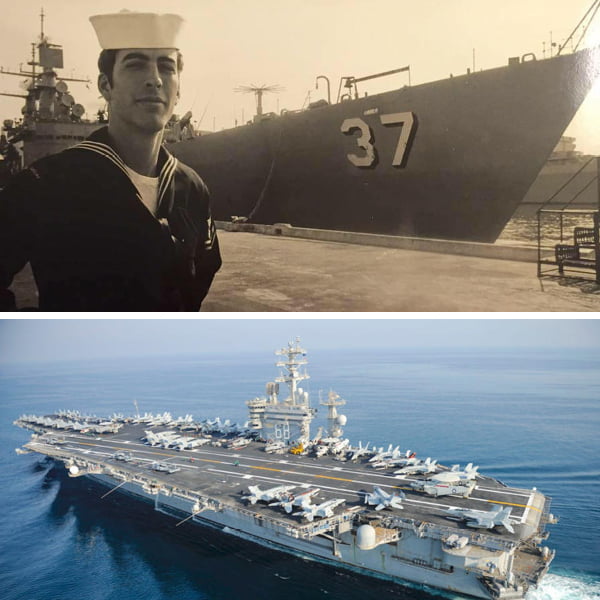Childhood
Born on June 26, 1961 on a farm south of Prosperity SC to David Edwin Bedenbaugh (farmer) and Linda Hancock Bedenbaugh (teacher).
Mike grew up roaming the fields and forest of his family farm as a child, exploring his hometown of Prosperity via his 1970 banana seat bicycle, and attending local Prosperity Schools. As a young boy he spent his summers living the life of a typical barefoot country boy; when he wasn’t collecting snakes and turtles for his backyard zoo or in the canopy of his mother’s backyard Mimosa tree collecting butterflies for his collection, he was fishing in the farm ponds in the pastures around his house. As a teenager, his summers were spent working in the fields, bailing Hay and straw as well as working inside his father’s feed and seed company on the square in Prosperity out of a building that his grandfather sold mules out of. During the fall he was in a tree stand hunting deer and, in the spring, hidden in camouflage calling up wild turkey; all with his dad who taught him the thrill of the outdoors and respect for wildlife. Mike was in the fourth grade when SC fully integrated schools. He loved high school (Mid Carolina) and participated in the marching band and was photographer for the yearbook. He graduated in 1979 and decided to attend Anderson Junior College (now Anderson University) because 1) his application to Clemson had been denied, and 2) it was close to party with his brother and best friend who were accepted to Clemson University. Realizing after a semester that school was not for him, he dropped out in February 1980.
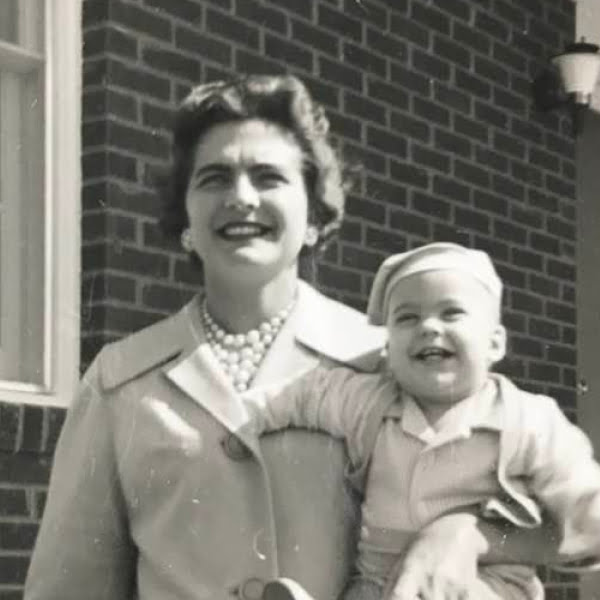
Mike and his mom, Linda
Return to College
Mike returned home to Prosperity, SC in 1986 and began commuting to the University of South Carolina. Due to his age of twenty-six, he was part of a group of older students that had returned to school and desired to create an organization to support older students. With the help of his professor, Dorothy Fidler, he helped form STRIVE (Students Returning for Invaluable Education) and became its chair. For the time in his life, and due to the discipline, he acquired from the US Navy, he excelled in scholastics maintaining a place on the Dean’s List every semester.
In the summer of 1988 as he entered his junior year, he moved from Prosperity to an apartment next to the USC Campus. To celebrate completing the move in one day, he attended the wedding of a friend outside Columbia and there met Doreen Sullivan. Doreen had just started a new marketing company with a childhood girlfriend in New York City named Post No Bills and was visiting a friend in SC who attended the same wedding. Mike and Doreen dated long distance, commuting between NY and SC during his Junior year at USC.
In the summer of 1989, Mike attended the intensive Russian Language School in Norwich, Vermont.
Marriage and New York City
Mike moved to New York City in May 1989 and transferred to Columbia University for his Senior year. Doreen and Mike married on September 3, 1989, in Columbia, SC.
In the fall of 1989, Mike’s wife Doreen and her company Post No Bills were approached by Jim Rissmiller, a concert promotor from Los Angeles California to help locate investors for a John Lennon Tribute concert. Rissmiller had been asked by Cynthia Lennon to create a concert honoring John Lennon on what would have been his 50th birthday. Rissmiller and Cynthia had developed a plan to have a stage positioned at the newly opened Brandenburg Gate in Berlin and host a music festival named The Come Together Concert. According to Rissmiller, the highlight of the show was to be a reunion of the three remaining Beatles which were to be joined by John’s first son Julian Lennon to stand in for him. Unfortunately for the project, it was pre-emptied by a last-minute concert organized by Yoko Ono to be held in Liverpool on May 5th. Rissmiller stated that he received word through Cynthia that Yoko Ono told Julian if he stood in for his father there would be serious financial ramifications. Between Julian pulling out, and the May 5th concert in Liverpool, all artists who had committed to the Come Together Concert in Berlin cancelled. With all the investment lost, and so much focus over the previous 7 months on the now cancelled concert, Post No Bills was edging toward Bankruptcy.
1990: Created F.O.B. Earth An export firm that leveraged personal relationships with Russian and New York apparel companies and supplied apparel to markets in former Yugoslavia. Mike spent the summer of 1990 visiting Soviet Union (Moscow, Yalta, and Leningrad) for potential business development. Prior to leaving for USSR, Mike wrote an article for The State Paper that summarized the 1990 governmental reforms in the USSR and the new office of President. Mike, with his knowledge of Soviet politics, expected a coup to occur against Mikhail Gorbachev and his government. He approached The State Paper in Columbia, SC to be “their man on the ground” in Moscow in case the overthrow occurred while he was present. The expectant Coup attempt did occur, albiet one year later in 1991. Mike also had a one on one meeting with Georgy Arbotov, Founder/Director of the Institute for US and Canadian Studies and advisor to 5 General Secretaries. Mike met Arbotov at a reception at the UN in NYC that was also attended by Henry Kissinger, George Fernandez, and Willie Brandt. Arbotov gave Mike his personal number and invited him to visit him in his office while in Moscow. During the meeting in Arboitov’s office in Moscow, Arbotov took Mike by the shoulder, pointed out toward the Moscow skyline, and declared, “…with American capital, all this can be factories and commerce”. Mike also met with Elem Klimov at his apartment in Moscow to discuss the possibility of making a film adaption of The Man Behind the Myth, a book written by Rasputin’s daughter Maria and coauthored by Patte Barham in 1977. Paramount VP Jerry Meadors was to be the Producer. HBO ultimately produced Rasputin: Dark Servant of Destiny in 1996 based on a pitch Jerry made to one of the writers. The final movie was unfortunately not from the perspective of his daughter Maria.
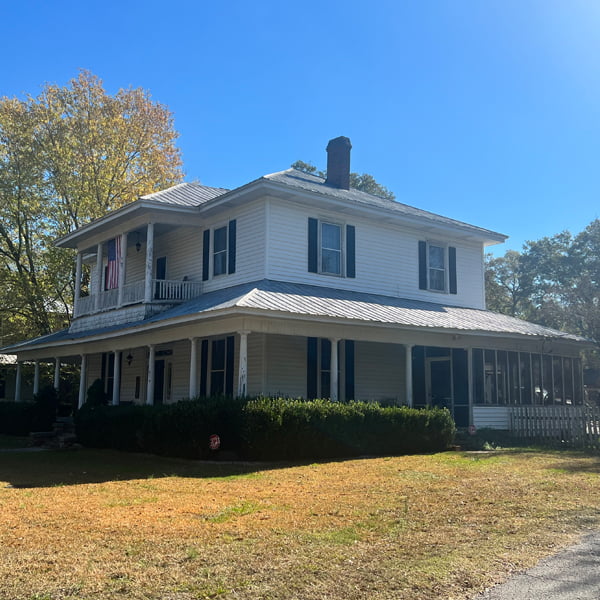
Mike’s grandmother’s house on Elm Street in Prosperity
Returning Home to SC
Following Mike’s return from the Soviet Union, and with the failure of the Come Together Concert, Post No Bills had to lay off the staff and prepare for possible bankruptcy. Mike made a call to his father in Prosperity, SC and plans were made to leave NY and move the company into Mike’s Grandmother’s Home on Elm Street in Prosperity to start over.
Mike worked to grow FOB Earth while Doreen worked to salvage Post No Bills. Though Mike had some preliminary success exporting close-out women’s clothing to former Yugoslavia, it was becoming risky doing business with eastern bloc countries during their transition to capitalism. Between that and Doreen needing help with a small untrained staff in a small SC Town, Mike took on the role of CEO of Post No Bills. With Mike managing the business and production management, it left Doreen to oversee the creative development of products. Within 6 years of the move to Prosperity, Post No Bills had grown to a company of twelve full time employees with a sales office in NY and LA, a fulfillment warehouse, Pad Print operation while retaining the corporate headquarters in Prosperity, with annual sales rising upward to $4,000,000 by 1998. Prompted by the growth of the business, and the pending delivery of their first child Carson, Mike and Doreen moved the company headquarters out of the personal home and into Mike’s great Aunts home nearby in Prosperity. The client roster had grown to include Philip Morris USA, RCA Records, Island Records, Polygram Label Group, Universal pictures, DreamWorks, MGM Home Video, while developing marketing support for music acts such as Melissa Etheridge, Drivin’ N Cryin’, Cranberries and Salt n Pepa. The leading film promotional projects during this period were for movies such as Scream, Chicken Run, Prince of Egypt, Gladiator, Almost Famous, and Shrek.
Following the birth of their second child Jacob, they moved out of Mike’s Grandmothers home and moved into his Great Grandfathers home 6 miles out of town. It was a magnificent 4300 square foot Victorian home and was a lifelong dream of Mike’s to live in it. It appeared that Dreams can come true.

Chicken Run Egg of the Month Club
for Dreamworks, SKG

Shrek Talking Pewter Mirror
for Dreamworks, SKG
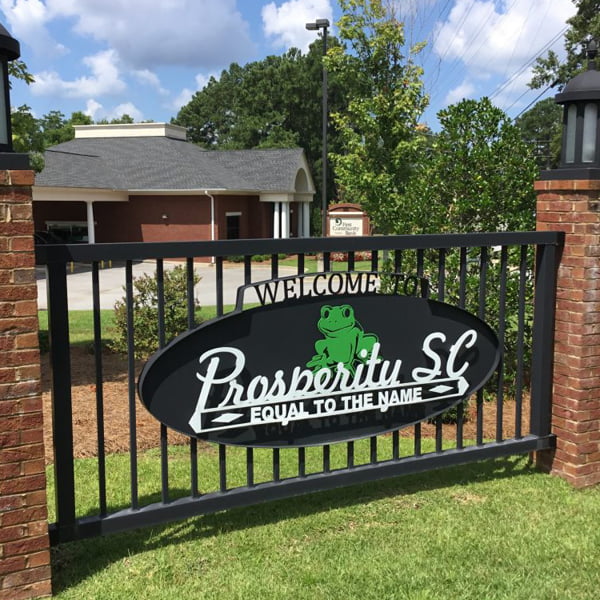
Prosperity, South Carolina
Politics and Community Leadership
Shortly after moving back to Prosperity in 1990, Mike noticed a crew from the town marking one of the largest and oldest trees shading the street they lived on. Upon realizing the tree was scheduled to be cut down, Mike began a public campaign advocating to keep the tree standing. Within a year, Mike was a member of the town’s Planning Commission and ultimately served as its Chair.
In 1995, Mike ran for Town Council, won, and served for two years until he had to abdicate due to moving out of town. Mike then became very active in County politics and served as a district representative on the newly formed Planning Commission and helped draw up the first comprehensive development plan for Newberry County. Once the plan was adopted, and the Board of Zoning Appeals was created, Mike served as Vice Chair and then Chair for over 6 years. It was during this period that Mike discovered the newly created Palmetto Trust for Historic Preservation, a statewide preservation non-profit. Mike became a financial supporter and joined the organization as a Board member from 1995 to 1997.
Band Management
In 1996 and advised by a friend to check into National Celtic/Rock musical act, Seven Nations who were playing at the Loch Norman Highland Games outside Charlotte, NC. Mike, Doreen, and several product managers visited the games, saw the concert and were impressed by their talent and unique sound. Following several meetings with the band’s leadership over the next year, the band agreed to allow PNB to manage their career and merchandise, with Mike being primary management contact. The highlight of the relationship was PNB producing a 90-minute concert television special with SCETV filmed at the Newberry Opera House for National PBS release titled “An Evening with Seven Nations”.
Due to conflicts with the band leadership over creative direction and business affairs, Mike backed away from directly managing Seven Nations shortly after the PBS special was broadcast. However, due to the exposure of the PBS special airing nationally, Dewars Scotch approached PNB for Seven Nations to appear at their annual sales meeting in Orlando. An outcome of that showcase was PNB negotiating a $250,000 sponsorship from Dewars Scotch for the tour the following year. The success of that tour led to a longtime associate of Doreen’s, Robert Urban, well connected entertainment attorney and manager of Michael Kamen and Elmer Bernstein, to take over managing Seven Nations.

Seven Nations / Dewar’s Sponsorship
Divorce and Renewed Purpose
The stress of running several businesses, with sales offices in two cities, while touring with a Celtic rock band while juggling a home and two young children proved too much of a burden on their marriage. Mike and Doreen separated in 2002 and divorced in 2004. PNB downsized, closed LA Office, and moved all company functions from Prosperity to downtown Columbia, SC.
After leaving Post No Bills, Mike felt a tremendous loss of purpose. He worked at various independent contractor jobs, from selling paint to selling health insurance, until finding renewed community purpose by teaching SC History, US History, US Government and economics for the middle and high school students in Newberry Academy; a private school in Newberry SC. Mike always saw these years as his “re-set” button as he tried to find purpose in his life after losing his business and his marriage. He also started a restoration and historic house consulting business for several years due to his love of old places. In 2007, Mike decided to pursue working with Palmetto Trust for Historic Preservation after discovering the organization was on the verge of shutting down following an extended period without an Executive Director. Mike submitted his resume and was hired by the Board of Directors on June 1, 2007.
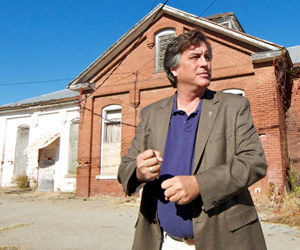
Mike in from of the historic bakery on the
Bull Street grounds
2007-2022: Executive Director of Palmetto Trust and
President of Preservation SC
Mike took the job as Director with only $30,000 in the annual budget. Mikes first job was to turn then organization from one of primarily advocacy to one that could create income out of real estate sales. He saw the success of organizations like Preservation North Carolina who were able to leverage the value of the historic buildings they saved into an income stream. The business model was to obtain ownership of endangered historic property, stabilize the structure and then sell to a buyer who would be obligated to restore it under a preservation easement.
Mike immediately went to work building value for the organization. Traveling the state, meeting with local preservation advocates, and building the brand of the organization as the state leader in preservation projects and advocacy, and creating connections that could lead to obtaining properties to save. During his tenure, Mike traveled over 500,000 miles, wearing out two Prius’ as he traveled every corner of the state and making numerous media appearances in print, television and radio; most notably six appearances on Walter Edgars Journal and over 100 appearances on WSPA channel 7’s morning show Your Carolina with Jack and Kimberly, later with Jack and Megan. Mike’s creative efforts lead to increased awareness of the plight of endangered places as well as the salvation of dozens of properties that otherwise would have been lost.
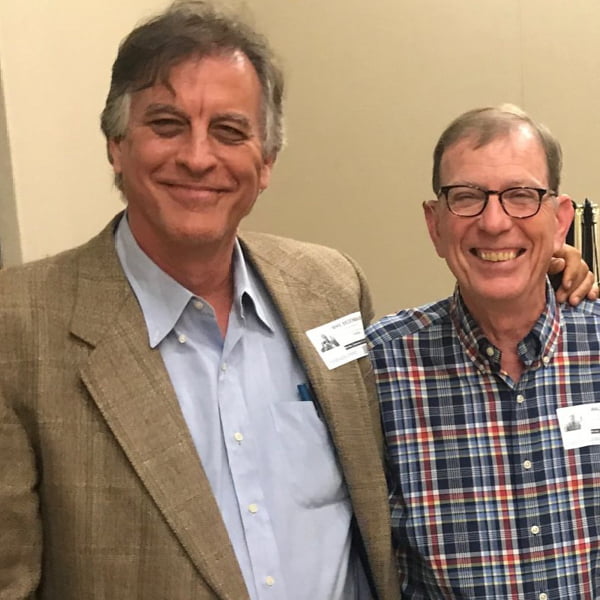
Mike Bedenbaugh with Walter Edgar
Some of the Most Prominent Preservation SC Projects:
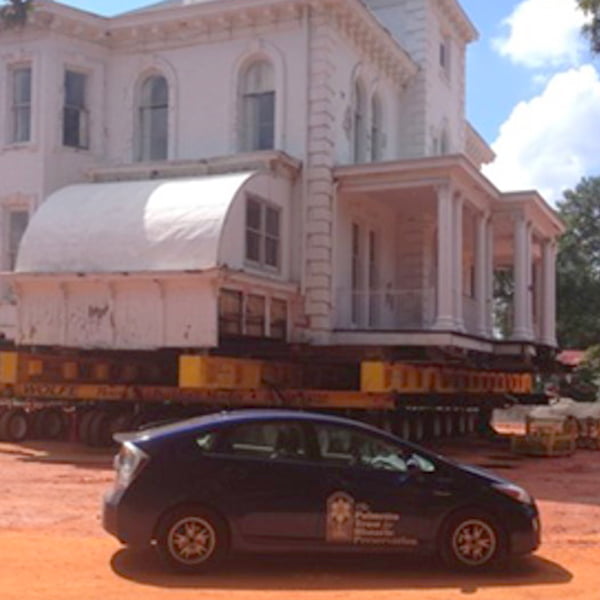
Wilkins House – Before Move & Restoration
Wilkins House, Greenville SC
Slated for demolition by a corporation that was planning to construct a nursing home on the property, the most significant Italianate Mansion remaining in Greenville was on the verge of being lost forever. Mike immediately went to work organizing a coalition of local leadership who were interested in seeing the place saved. Following the rejection of the idea to incorporate the house into the nursing home by the development company, the Save the Wilkins House initiative went to work trying to convince Greenville Planning Commission to intervene. At one of the meetings a local entrepreneur and developer, Neil Wilson, came forward and stated that he will restore the house if someone would come forward and move it. Mike immediately approached Neil and declared Palmetto Trust would be that group. It was a bold move since the organization had never raised more than $10,000 at any one event from the Greenville community, but Mike hoped that this high-profile project would inspire community support. It would involve moving a solid masonry structure weighing over eight hundred tons and would be the heaviest structure ever moved in South Carolina. After six months of media campaign and community leadership support, Save the Wilkins House Initiative raised the $300,000 needed to move the massive house two blocks to its new resting place. It is now a private home protected by historic easement held in trust by Preservation SC.
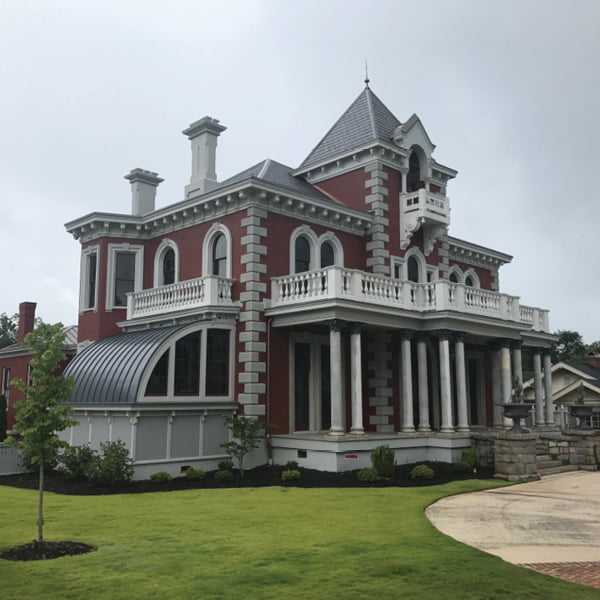
Wilkins House – After Move and Restoration
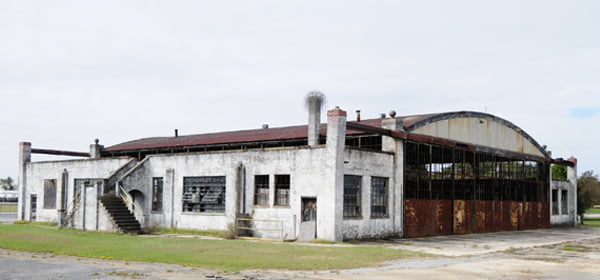
Curtiss-Wright Hangar – Before
Curtiss-Wright Hangar, Columbia, SC
The Curtiss-Wright Hangar was constructed in 1929, located at Jim Hamilton-Owens Airport and owned by Richland County in Columbia, SC. The hangar was in a terrible state of dilapidation but the County Commission responsible for the property was unsure how to utilize it. The structure was large, leaking with much of its glass broken. Without public funding available to take on such a huge and expensive project, the commission in charge of the building, being sensitive to its cultural importance to the community, reached out to Mike and Robin Waites, Director of Historic Columbia Foundation, to meet to discuss what options are available to ensure its stability. Mike suggested that the Commission should sell it on the open market and attract an investor who would restore it through Historic Tax Credits. The Commission leadership was concerned it could not be sold due to it being owned by the county and there was public trust involved to ensure it was not demolished. Mike proposed utilizing an easement with Palmetto Trust to protect the property and then the public trust would be protected. The county agreed to this creative solution and the property was able to be sold, protected by an easement, and put into use as a brew pub.

Curtiss-Wright Hangar – After

Frances Jones House – Before

Frances Jones House – After
Frances Jones House and the Daufuskie Endangered Properties Program
Located on Daufuskie Island, The Frances Jones house is just one of dozens of historic Gullah built cottages remaining on the island. Though development had taken over 1/3 of the bridgeless island’s property, it still retained the largest collection of original Gullah built homes in the Gullah Geechee Cultural Heritage Corridor. Many of the homes were abandoned and empty and in various states of deterioration as most of the property owners had moved to Savannah or other places for better job opportunities but retained ownership. Mike was invited by the Daufuskie Island Historical Foundation to visit the island and help advise ways to save the historic buildings remaining on the island. Mike saw a tremendous resource that could possibly bring income to the owners of the properties. Understanding the high sensitivity to people losing their homes and property to unscrupulous developers and hoping to develop a way to attract grant money to private property, Mike developed the Daufuskie Endangered Place Program (DEPP). The program envisioned Palmetto Trust for Historic Preservation signing a long-term lease for the property from the property owners, and, under the control of the lease, DEPP would apply for grant money to restore the structure. Then, DEPP would lease out the property for vacation rental to recoup the funds. Once the funds are recouped, DEPP would release the property back to the owners and utilize the returned funds to “revolve” into restoration of another at risk structure. The first property that DEPP restored was The Frances Jones House. Frances Jones was a well-respected leader on the island throughout the last half of the 20th century and her house was a landmark on the island. When Mike first visited it, part of the roof had been lost and most of the floor sills had been destroyed by termites. However, enough of the house remained to be worth restoring. Following six months of discussions, the sole owner, Mr. Paul Johnson, Frances Jones’ nephew and brother to Savannah mayor Otis Johnson, signed the lease agreement and DEPP started work on the restoration of the house utilizing a grant from The 1772 Foundation based in Rhode Island. While restoration was underway, it was discovered that the house had been constructed in two phases. The first phase was a small one room house with an attic space accessed by a small ladder step. It was constructed in the 1870s out of what appeared to be salvaged materials from a previous structure, likely a dismantled slave dwelling from one of the nearby plantations. The second part was constructed in the 1950s by Ms. Frances herself and tripled the size of the house, adding two bedrooms and a den.
The second house DEPP restored was the Hinson White House. Though it was owned by a white family from Asheville, it was built by Gullah builders around 1915 and thus qualified. The projects were seen as such a success that DEPP won a Project Award from the SC African American Heritage Commission at their annual conference in 2016. Though the project had a lot of support from several leaders in the Gullah Community, including Emory Campbell, Sallie Ann Robinson, and Marquetta Goodwine, there was strong opposition to the program in the Gullah community who was influenced by negative comments made by Dr. Herman Blake, at the time Chair of the Gullah Geechee Cultural Heritage Corridor and his protégé, Ervin Simmons, chair of the Daufuskie Island Foundation. They insisted on ensuring no one would work with Mike and Palmetto Trust due to fears it was a ruse by a white business owner to take over Gullah owned property. Unfortunately, between their negative voice, the divisive issue of heirs property, and the lack of meaningful philanthropic support from the nearby resort communities, no other Gullah owned properties were restored under the program. Mike still considers DEPP a success in that without it, Frances Jones House, the most historically significant Gullah home on Daufuskie, would have been lost.
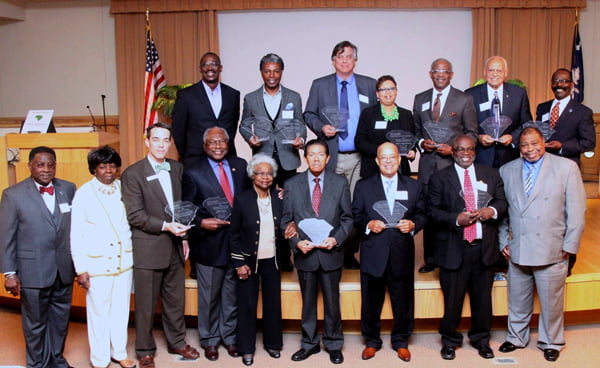
In 2016, Mike received a “Project Award” from the South Carolina African American History Commission for his work on developing the Daufuskie Endangered places Program and the restoration of the Frances Jones House.

Laurelwood Plantation
Before Restoration
Laurelwood
In 2009 Mike was informed of an abandoned plantation house hidden in the forest off a dirt road in eastern Richland County. Mike explored the area and discovered the 1847 home partially hidden by bamboo in a terribly dilapidated shape; 10% of the roof was missing and the interior had been vandalized by intruders, stealing several of the original mantles. Mike immediately began negotiations with the property owners who agreed to sell the property. After obtaining a grant from The 1772 Foundation, Palmetto Trust had the funds available to purchase the house property.
With the help of a grant from the Richland County Conservation Commission, the house was stabilized and placed on the market for sale with protection under a preservation easement. A couple from England purchased the house and completed the restoration in 2011.
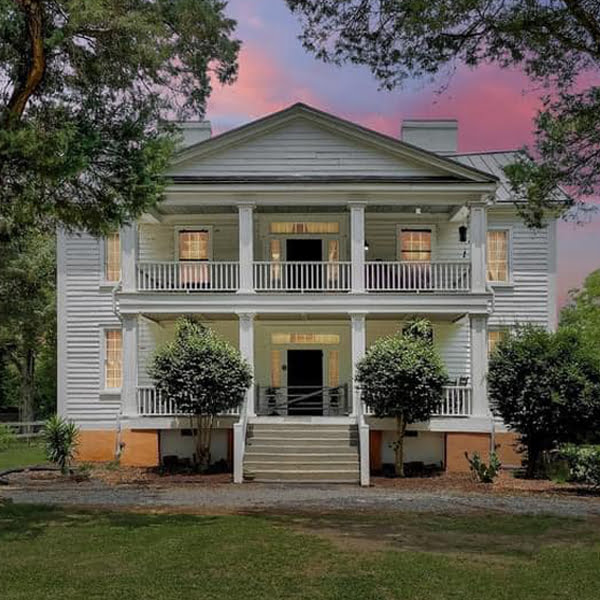
Laurelwood Plantation
After Restoration
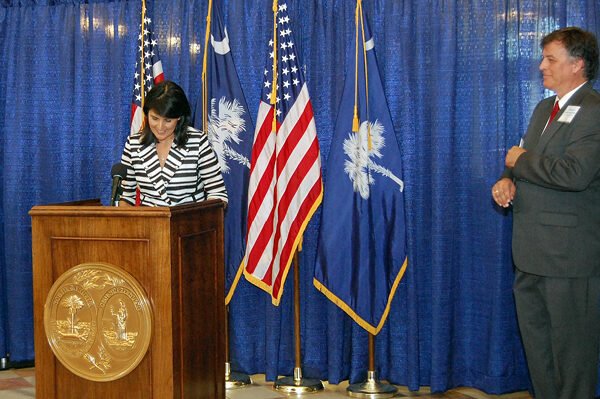
Left: Former SC Governor, Nikki Haley
Right: Michael Bedenbaugh
Abandoned Building Revitalization Act
In 2010, Inspired by the possibility of attracting development to the abandoned portions of the historic Mental Health facility in Columbia, Mike met with Tax Credit attorney Chris Rogers and local Representative James Smithconcerning the creation of a new state tax credit that would attract investment to dilapidated properties with the hope was that it would facilitate renovation of empty historic buildings in the states small town centers. After three years of efforts working behind the scenes in the SC State House, the bill finally passed almost unanimously in both house and senate. Governor Niki Haley signed the bill into Law on June 11th, 2013.
Sacred Spaces Program
In 2016 Mike met Bill Fitzpatrick, Greenville businessman who had just written a coffee table book titled Sacred Spaces of South Carolina. Mike had always wanted to figure out how to help save the growing number of empty and abandoned historic churches across rural SC. He saw this book as the way to do it. Bill was so moved by Mike’s pitch, he donated the book’s publishing rights and all proceeds from the sale to Palmetto Trust, later renamed Preservation South Carolina to fund a new Sacred Spaces Program. The goal of the program is to attract financial intention to these empty church buildings so they can survive until a new use can be found to sustain them. Places of worship were constructed for the purposes of assembly, and it is tremendously difficult to create a sustainable use for rural church buildings once the congregation has left the community. However, the project has been highly successful in saving several church structures. Some highlights of this program are Good Hope Baptist Church and Trinity Episcopal of Abbeville.
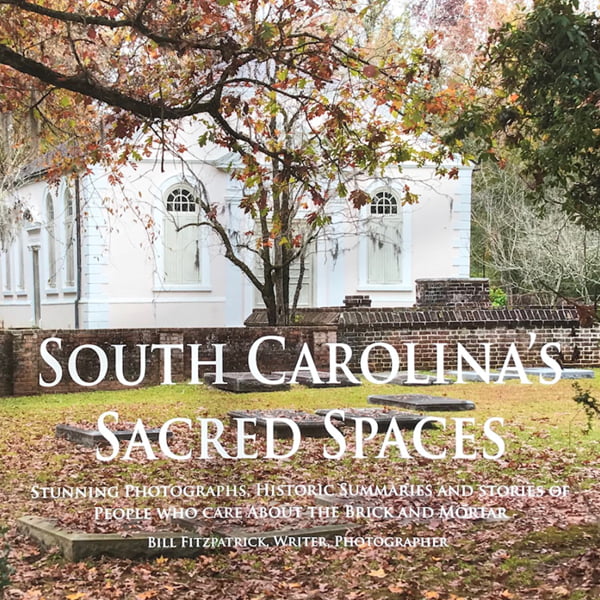
Souther Carolina’s Sacred Spaces, By Bill Fitzpatrick
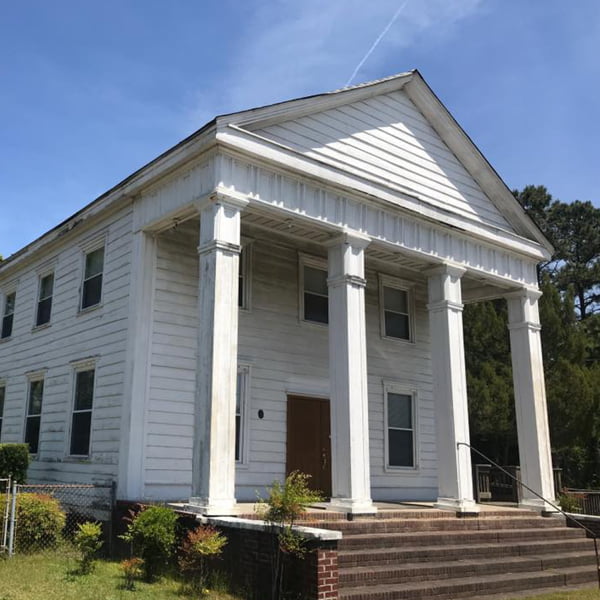
Good Hope Baptist Church, Richland County, SC
Good Hope Baptist Church
Good Hope Baptist Church. Constructed in 1857, Good Hope is a classic Greek revival structure that is a landmark on the highway between Columbia and Sumter SC. The leadership of the Baptist Conference contacted Mike in 2019 to discuss ways to save the structure since the congregation was down to three members, all located in nursing facilities. The Baptist Conference Office in Columbia agreed to deconsecrate and donate the church building to Preservation SC if it would be protected by a Preservation Easement when it was sold. Prior to taking possession, the Baptist Conference was awarded a grant to restore the original windows and paint the exterior. When PreserveSC took possession, they immediately marketed the property for sale. Within 30 days, an independent ministry came forward and offered to purchase it for his mostly African American congregation. It is currently being used as a place of worship by a nonaffiliated congregation.
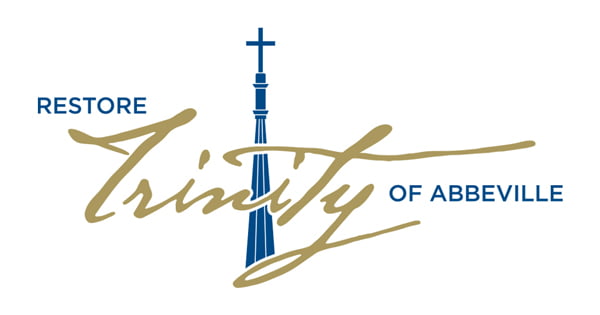

Trinity Exterior Before
Trinity Episcopal Church, Abbeville, SC
The first major project undertaken by Mike as project director for the Sacred Spaces Program was actually not for an abandoned church, though it did have a congregation that had diminished to the size that made it difficult to raise the funds necessary to make much needed repairs. The church was part of the Episcopal Diocese of Upper South Carolina. The Trinity Episcopal Church sanctuary had been shuttered by the Diocese in 2017 for safety reasons, forcing the remaining communicants to use the nearby parish house for services. When Mike first visited the building’s interior and spire in September of 2018 with Preserve SC Board leadership, he found the interior plaster severely damage from massive rain intrusion, the 160 year old 10 X 10 framing timbers of the steeple base were so severely compromised that the 125-foot-tall spire was leaning dangerously over the sanctuary by 15 degrees, the extraordinary windows designed by William Gibson of NY were in need of refurbishing, and the rare John Baker organ installed in 1860 was inoperable. On top of that, the exterior stucco of Portland cement left from a very bad restoration 40 years before, had so damaged the historic masonry that it needed to be removed, repointed and historically appropriate stucco applied. The once large congregation that once could fill the 400-person capacity sanctuary had in the past several decades dwindled down to a little more than two dozen members with only a portion still active in church affairs. The congregation did have a maintenance fund of just over $360,000 available for repairs and maintenance but has sat unused for years, and was far short of the estimated $3,000,000 it would take to fully restore what many considered the crown jewel of the community.
Mike and Bill Fitzpatrick with support from President of Friends of Trinity (a separate secular non-profit created to support the congregation in fundraising) Ann Waigand created a proposal for the Upper Diocese to sign an option agreement that would allow Preservation SC to seek out a private developer to take on the massive estimated $3,000,000 expense to fully restore the structure utilizing historic tax credits and develop then property as a for profit event space under the condition that it will be available for worship by the remaining members and general public every Sunday Morning, Christmas and Easter. Bishop Andrew Waldo had agreed in principle to this creative solution, the diocese building committee approved the idea, and the diocese legal team began drawing up an option agreement. When news of this agreement was heard in the community, an anonymous donor stepped forward with a pledge of $390,000 to go toward the restoration only if the diocese does not allow the building to be sold. A meeting was held between the Bishop, Building Committee, Mike, and Bill to decide between go forward with the option to sell without the extra money, or, to not sell and have the funds to start renovation. Mike proposed an arrangement inspired by the Daufuskie Project where the Diocese would lease the property to PreserveSC, who would take responsibility for building access, consolidate all fundraising efforts, and manage repairs to the spire, roof, and damaged stucco. Bishop Waldo suggesting a 5-year term, gave his blessing to the agreement and the lease was signed, turning over $360,000 of the unutilized maintenance fund for the exclusive use by Preservation SC. The diocese would control the $390,000 donated by the anonymous donor, and Preservation SC would be responsible to raise the remaining dollars to restore the church. Though Mike had hoped the initial $750,000 would be enough to restore the spire and leaking roof, it was not to be. It was decided to focus on the most traumatic problem with the structure: leaking roof, masonry repair of the crenelations, and leaning spire.
The initial project was divided into two phases:
- Phase 1: Utilize the $750,000 funds in hand to stabilize the leaking roof, repair the masonry crenelations, install new interior gutters, remove damaged interior plaster, restore plaster in the chancel, and upgrade all electrical and HVAC systems.
- Phase 2: Restore the 125-foot-tall spire roof and return it to its upright position.
Meadors Inc, Charleston, SC was hired by PreserveSC to be architect of record to oversee the project and Midwest Maintenance LLC, Augusta GA was the contractor hired to manage the construction. As work began on Phase 1, Preserve SC partnered with Friends of Trinity and together developed a team to oversee fundraising efforts for the estimated $700,000 needed to repair the steeple. A $250,000 grant was awarded by the National Fund of Sacred Spaces, a grant fund administered by The National Trust for Historic Preservation. However, it required a match of $500,000 for eligibility. PreserveSC went to work raising funds and within 7 months raised the needed match from various sources: Watson Brown Foundation grant of $125,000 and National Park Service grant of $220,000 for Hurricane Irma Relief (the spire was severely damaged by heavy winds as Irma p[assed through Upper SC). The remaining funds came from private donations, the largest of which were The Church of the Resurrection, Greenwood SC $11,780.00, St. James Parrish, Charleston SC $10,000. The largest single donation came from Developer Bob Hughes of Hughes Development Corporation in Greenville of $25,000. With the funds in hand the team went to work on the spire. When the spire was constructed in 1860, at 125 feet, it was the tallest spire in SC outside Charleston and Columbia. The interior engineering of the spire, designed by architect George Walker, was an inspiring frame of heart pine timber. It was decided to reject an engineering proposal that would have replaced all wooden elements with steel and hire timber framers to restore the original timber frame engineering of the spire. In a process that took 4 months a 175-foot-tall crane was brought onto the site, the spire was detached and lifted off its base, new treated timber was installed, and the original spire was then lowered and attached to its new foundation.
Shortly after the successful completion of Phases 1 and 2 of the Trinity Project in 2020, and due to the death of his 94-year-old father on Dec. 30th of that same year, Mike announced in 2021 to the Board his decision to leave PreserveSC after 14 years of service.
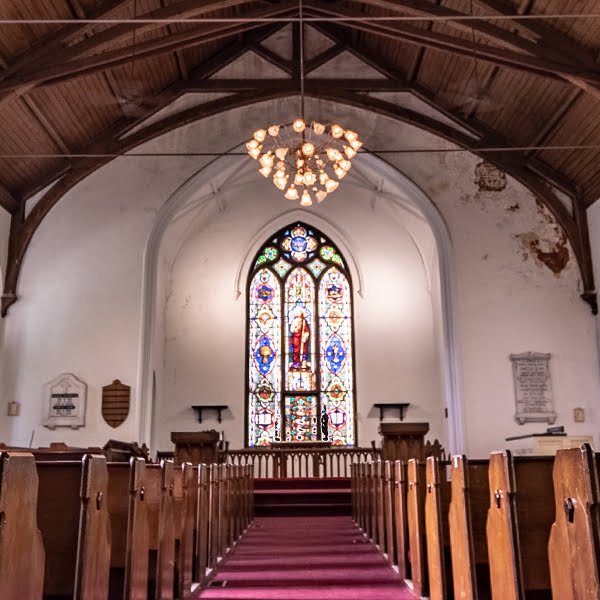
Trinity Sanctuary Before
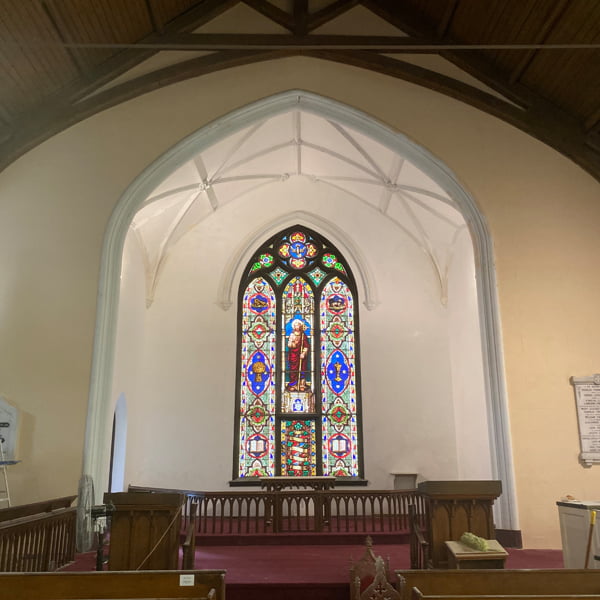
Trinity Sanctuary – After

Mike Recieves the Order of the Palmetto
From Then to Now…
For his service to the advocacy and preservation of South Carolina’s historic structures, Mike was Awarded the Order of the Palmetto by Governor Henry McMaster.
In 2010 Mike was blessed to meet Andrea (Anya) Demos Pridmore, an amazing and dedicated teacher from Greenville SC. Anya left her home in Greenville and moved to Prosperity to share her life with Mike in 2012. Due to their mutual love of Daufuskie Island and its wonderful community of friends and supporters, Anya and Mike were married in a private ceremony on July 8, 2016 in the historic First Union African Baptist Church located in the heart of Daufuskie’s historic district.
Since retiring from Preservation South Carolina in 2022, Mike has begun several business ventures as an entrepreneur and developer.
Prosperity Antiques LLC, brand name “Mikanya” is an antique/vintage retail outlet that Mike and Anya own together and distributes via online sales and antique booth’s in central SC.
Bedenbaugh Rental Properties LLC is a company started by Mike’s father, David, in 1985. Mike will continue his father’s work investing in properties and restoring for sale with a focus on historic properties.
Preservation Solutions LLC is a company created to function as a consulting agency to clients restoring historic buildings specializing in advocacy issues, Historic Tax Credits, National Register listing and project management. Mike is joined by Historic preservation specialist Carolyn Coppola as a principal member in the corporation.
MAP Media LLC is a company that will produce not only produce books, Like the current release “Reviving Our Republic: 95 Theses For the Future of America,” but also a Podcast titled Perspective with Mike Bedenbaugh, and creates content for YouTube/tic-toc/Instagram/Spotify/Facebook and other social media Platforms.
Mike is a licensed Realtor currently with SVN Blackstream and Christies Blackstream International specializing in both commercial and residential historic properties in SC and newer built homes near his family farm on Lake Murray.
In January 2024, Mike announced his candidacy for the House of Representatives in the SC Third District. He was nominated by the Alliance Party of SC to be on the ballot with an endorsement from the Forward Party of SC.
Mike currently resides on his grandfather’s restored farm 6 miles south of Prosperity with Anya and their rescues: Mimi, Boo, Mary and Koshka.

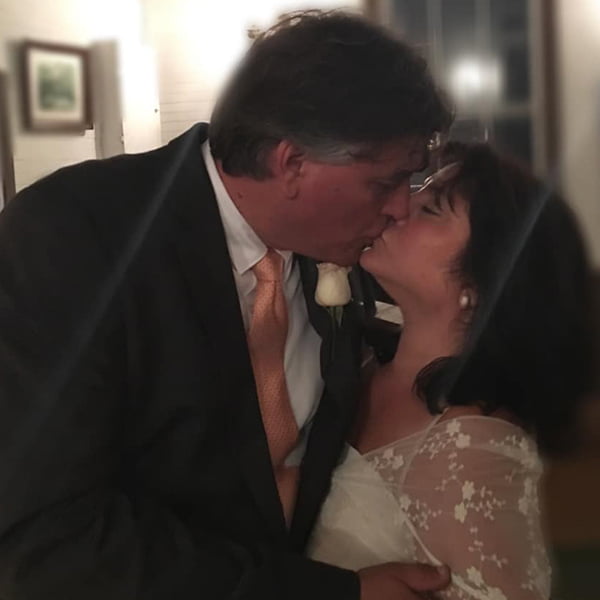
Mike and Anya Bedenbaugh
Married July 8, 2016

